MARKETING
50+ Terms You Need To Know
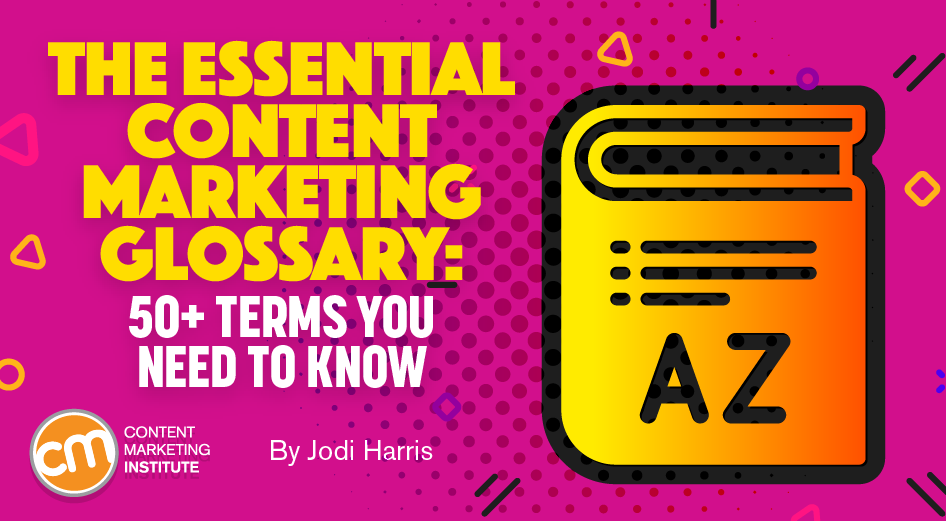
On the surface, content marketing seems straightforward: Create great content, publish it on channels popular with your audience, and reap business benefits from their attention and interest.
Of course, we all know there’s a lot more to it. But it can be hard to dive into the nuances, complexities, and conditional decision-making when struggling to understand the basic principles, techniques, and tactics. Even seasoned veterans can interpret key terms differently, leading to challenges in communicating and implementing strategies.
You can’t dive into the complexities of #ContentMarketing until you know many of the terms. That’s why @joderama developed this glossary via @CMIContent. Click To Tweet
To help clear the confusion, I put together this glossary of common content marketing terms. While consensus on all definitions isn’t possible, it is possible to have your team agree, and that’s the strong foundation needed.
Note: I organized these definitions into best-fit categories though many can span multiple areas.
Strategy-centric terms
Audience
In a marketing context, audiences are targeted, clearly defined groups of individuals and/or organizations that willingly read, listen, view, or otherwise engage with your brand’s content in exchange for benefits they expect to receive.
Definitive resource: Your Audience Is Not the Same as Your Marketing Database
Buy-in/business case
A business case captures the reasoning for an organization to invest in content as a component of its marketing strategy. Typically delivered to executive management in the form of a document or presentation, it’s a helpful tool for building stakeholder understanding and support necessary to execute the program effectively.
Though talking points can vary, at a minimum, your business case should address:
- Why your company needs content marketing
- How it can help your organizations meet its marketing goals
- Necessary budget and resources
- Expected outcomes and estimation of when they will be achieved
Definitive resource: How To Make a Better Case for Content Marketing in 2021
Content marketing
CMI defines content marketing as “a strategic marketing approach of creating and distributing valuable, relevant, and consistent content to attract and acquire a clearly defined audience – with the objective of driving profitable customer action.”
But as A. Lee Judge recently asserted, content marketing is more than a marketing strategy that uses content to attract an audience – it’s a skill set. “It’s no longer enough to market with content. You must understand how to market the content itself,” he says. Thus, he offers a complementary expansion to the definition as a verb: “Applying marketing skills and techniques to written, visual, audio, or social content to provide the greatest possible reach, longevity, and effectiveness of that content.”
#ContentMarketing is both a discipline and a skill set, says @joderama and @aleejudge via @CMIContent. Click To Tweet
Definitive resource: Are Inbound Marketing and Content Marketing Still Different in 2021?
Content marketing strategy
Copyblogger defines content marketing strategy as a plan for building an audience by publishing, maintaining, and spreading frequent and consistent content that educates, entertains, or inspires an audience. However, CMI uses a simpler definition: Your content marketing strategy is your why – why you are creating content (your business goal), whom it will serve (your audience), and how it will be unique (your mission).
Definitive resource: Developing a Content Marketing Strategy
Content strategy
Content strategy operates above a content marketing strategy. It is a plan for creating, managing, and distributing all content produced and shared across the enterprise – not just the content used as part of a content marketing program or initiative. For example, how content is designed and developed to deliver an optimal user experience is a consideration that would fall under a content strategy, not a content marketing strategy.
Content mission statement
A content mission statement is the centering principle of your brand’s unique vision of content. Ideally, this statement reflects your business values, distinguishes your storytelling from competing content, and governs your content team’s creative and strategic decision-making, including:
- What stories your brand will tell (e.g., topics)
- How those stories take shape (e.g., core content formats and platforms)
- How your content assets work collectively to create a desirable experience for your audience
Definitive resource: Make a Mission Statement for Better Content Marketing
Goals
Goals can be defined as the business outcomes to be achieved through your content marketing strategy. While the ultimate goal is to drive profitable action, program goals should be more specific, such as to grow sales, to save the company money, or to drive greater customer loyalty and brand satisfaction. Goals also must be measurable and have a designated achievement date.
Definitive resource: How To Set Content Marketing Goals That Matter to Business Leaders
Personas
A persona is a composite sketch of a target audience’s relevant characteristics based on validated commonalities. Used to inform your strategic plans for reaching, engaging, and driving your audience to take meaningful action as a result of your content. Without well-researched personas, you likely guess what your audience wants and often revert to creating content around what you know best (your products and company) instead of around what your audience actively seeks.
Definitive resource: Marketing Personas: A Quick and Dirty Guide
Planning/Process-centric terms
Channel/media planning
Media planning is the process of making decisions about where, when, and how often to deliver a message to an audience. The ideal is to reach the biggest number of the right audience members with the right message only as often as needed to achieve the desired effect (e.g., brand awareness, leads, sales).
Similarly, a channel plan – including social media planning – is an advanced directive for how your brand manages its content on the ever-evolving list of media platforms. It spells out the rationale and the expectations for using each channel. Compiling this guidance ensures you aren’t wasting time – and budget – on distribution efforts that can’t help you achieve your content marketing and business goals.
Definitive resource: Social Media Content Plan: Take Control of Your Strategy
Content brief
Often provided to freelancers, consultants, and other outsourced writers assigned to create content, a content brief documents the guidelines and instructions to ensure a properly focused asset that meets the brand’s editorial standards and marketing expectations. A well-constructed brief should include an elevator-pitch description of the assignment, relevant branding details (e.g., tone, voice, and stylistic considerations), key messages, and target audience insights.
A well-constructed #content brief includes an elevator-pitch description of the assignment, target audience, and key messages, says @joderama via @CMIContent. Click To Tweet
Definitive resource: How To Create a Good Brief for Better Content Marketing
Content inventories and audits
According to Paula Land, author of Content Audits and Inventories: A Handbook, a content inventory is a collection of data about your content. It’s a comprehensive, quantitative list – typically created in a spreadsheet – of all content assets, ideally across all content types, channels, and distribution formats. It enables marketers to make data-based content decisions.
In contrast, a content audit, as defined by Paula, is a qualitative evaluation of the inventoried content. Assess your content against customer needs and business objectives to identify which assets are performing well (and which aren’t.)
Definitive resource: A Simple-To-Do Content Audit With 6 Questions
Content/editorial plan
A content or editorial plan is a tactical outline to execute your strategy that denotes responsible team members. It should detail such things as key topics, content to create, publication dates, distribution plans, and calls to action.
Definitive resource: How To Create a Flexible Content Plan That Gets Results
Content operations
Content operations are the full complement of processes, tasks, people, and procedures to manage efficiently and effectively everything content-related within your organization, from strategy and planning to governance, execution, measurement, and optimization.
Definitive resource: How to Build a Content Operations Framework (and Why You Need One)
Editorial calendar
An editorial calendar is a process tool to track all the moving parts in executing your content plan. It typically includes the topic, title, author information, and images for each asset and the schedule for publication and promotion organized according to workflows established for creation and production.
Definitive resource: How To Create a Strategic Editorial Calendar
Content workflow
Workflows are sets of tasks that a team needs to complete a content asset. In her book, Content Strategy for the Web, Kristina Halvorson says a content workflow determines “how content is requested, sourced, created, reviewed, approved, and delivered.”
At a minimum, they should outline critical tasks at each stage of the editorial process. Here’s a simple example:
- Outline
- Write
- Review
- Edit
- Approve
- Publish
Definitive resource: Marketing Workflow: How To Keep Content Production on Track
Creation-centric terms
Copy editing, proofreading, and fact-checking
These editorial techniques are used to ensure the highest level of quality, clarity, and accuracy in content. Each serves a different purpose and uses distinct approaches:
- Copy editing: This involves reviewing and editing content for any mechanical errors or stylistic inconsistencies that might impact the quality or readability of the piece. Tasks include checking written material for grammar, spelling, linguistic, or punctuation issues. A copy editor may also do a rewrite, if necessary, to fix problems with transitions, wordiness, jargon, and style.
- Proofreading: Proofreading is a separate stage of the editing process. Here, a proofreader scrutinizes the content in its almost-published state to catch any typographical or minor errors that were missed in editing or created during production.
- Fact-checking: Fact-checking is then conducted to verify the factual accuracy of the content and its use of sourcing. It ensures the content doesn’t spread disinformation, miscredit or misquote sources, get dinged for plagiarism or copyright infringement, or otherwise risk losing the trust of your audience (and possibly face legal penalties.)
Definitive resource: The Best Proofreading and Editing Tips (Spoiler: Don’t Do Them at the Same Time)
Curation
Curation is the assembly, selection, categorization, commentary, and presentation of relevant content. The technique typically involves third-party content in which your brand puts your spin on others’ content. It also can be applied to curating content published by your brand.
Definitive resource: Content Curation on Social Demands More Than a Shared Link
Distribution/promotion-centric terms
Accessibility
Accessibility is the ease anyone should have navigating, understanding, and using your content. Often used in the context of conditions, such as visual or auditory impairments, such as someone who prefers to mute videos and read the captions.
Calls to action (CTAs)
Calls to action are statements or design elements highlighting actions you want the audience to take after engaging with the content, such as subscribing to your newsletter, attending an event, or exploring other relevant assets and offerings. The best CTAs are simple, clear, inviting, and easy to notice.
Channels
Channels are individual content distribution outlets, such as a blog or podcast channel, Facebook, Twitter, TikTok, YouTube, or Vimeo.
Formats
A content format refers to where the content can be accessed or its presentation for distribution and engagement, such as text via in a printed book, a digital magazine, or an SMS campaign; audio for a podcast; or visuals for like a video or infographic.
Keywords/key phrases
Keywords or key phrases describe the contents of a content asset based on terms people use to search for content on that topic. They are the building blocks of a search engine optimization (SEO) strategy.
Owned media
Owned media distribution platforms are fully under your brand’s control, allowing you to decide where and how it appears, how it is accessed, and how it fits in with other aspects of the content experience.
Shared/social media
Shared media, including social media, provide opportunities for marketers to post content, create and listen to conversations, and interact with people. These platforms are ultimately controlled by a third party, which can change its policies and procedures – or cease operations altogether – at a moment’s notice.
Native advertising
Native advertising is a paid/third-party promotion format that supports either brand or direct-response goals and is where the content matches the form, feel, function, and quality of the content of the media on which it appears.
Definitive resource: How to Do Native Advertising Right: A Brief Guide With Great Examples
Branded content
Wikipedia defines branded content as content funded or outright produced by an advertiser. Like native advertising, it works by partnering with relevant publishers that have the trust of your target audience. This technique takes a more immersive, sensory-driven approach to storytelling, making the experience more entertaining, valuable, and memorable.
Paid search
These opportunities typically take the form of pay-per-click ads or other sponsored listings that appear near the top of search engine results pages (SERP) when consumers search for information relevant to your content.
Influencer marketing
One of the fastest-growing marketing techniques (as well as a burgeoning industry of its own), influencer marketing programs enlist the assistance of people who have the ear of your target audience to bring your content to their attention.
Definitive resource: How to Turn Influencers into a Powerful Content Force
Content personalization
Personalization is the process of targeting content to individuals based on one or more of the following: who they are; where they are; when, why, and how they access content; and what device they use to access it. Given the high competition for getting attention online, marketers use this technique to make their content more findable, engaging, and personally resonant to their target consumers and existing customers.
Search engine optimization (SEO)
SEO is a set of strategic techniques and tactics designed to get content to rank as highly as possible on search engine results pages (SERP) on Google and other search sites. The higher your content ranks, the more likely it is to receive a click, which increases traffic to your content.
Definitive resource: Providing the Best Answer May No Longer Be the Best Strategy for SEO [Video Series]
Content segmentation
Segmentation refers to the categorization of content based on the target audience niche (similar to a buyer persona). Content is presented in a clear and concise manner specific to that audience. Often affecting design, messaging, and presentation, content segmentation can improve engagement, better differentiate your brand from competitors, and improve content marketing effectiveness.
Definitive resource: 8 Expert Tips To Help You Personalize Your Content and Segment Your Audiences
Sales-centric terms
Account
Account is defined as a sales target, opportunity, or customer group established within the total addressable market.
Account-based marketing (ABM)
ABM is a B2B marketing approach where high-value (typically enterprise-level) organizations are identified, and content is created to target them as a grouped unit rather than marketing to individual members of that organization.
Definitive resource: Account-Based Marketing (ABM) Crash Course for Content Marketers
Buyers
Buyers are prospects – people who are in need of, or have an active interest in, purchasing a service or product.
Consumers
While the term is often used interchangeably with “buyers,” from a marketer’s perspective, consumers are the people who are likely or intended customers for their business.
Customers
While buyers and consumers are terms used to indicate interest or intent, customers are the individuals or organizations who have actively made a purchase from your business or brand.
Conversion
A conversion takes place once a consumer has taken an action your organization designates as meaningful – such as purchasing a product, registering for an event or a gated asset, subscribing to a blog, newsletter, or joining a social media community – after engaging with your brand’s content.
Definitive resource: How To Create High-Converting Content
Demand generation
Demand generation is the focus of targeted, sales-centric marketing programs designed to drive awareness and interest in a company’s products and/or services. The greater the demand, the easier it becomes for sales to nurture that interest to convert.
Definitive resource: Demand Gen for Content Marketing in the Next Decade [New Research]
Ideal customer profile (ICP)
An ICP is a description of a targeted buyer (person or company) that’s a perfect fit for your brand’s solution.
Journey map
This term refers to a method of identifying information and assistance consumers likely need at each possible interaction and is used to determine the most effective content to nurture them toward conversion.
Definitive resource: Wondering What Content To Create? Try a Customer-Journey Map
Lead
In marketing terms, a lead is a person or business in your company’s sales or marketing database, typically (though not exclusively) by engaging with a branded asset or communication platform.
Definitive resource: Make Content Integral to Your Lead Generation
Lead scoring
Scoring is a marketing method of objectively and comparatively evaluating the quality and conversion potential of a prospect based on predetermined sales criteria.
Marketing-qualified lead (MQL)
MQLs are leads reviewed by the marketing team that satisfies the criteria to be passed along to the sales team as someone who may become a customer at some indeterminate point.
Sales funnel/funnel stage
The sales funnel is a method of defining the decision-making process of a customer from the time they enter the marketplace through the purchase (or conclusion not to buy). It’s commonly used to determine the most effective outreach approach to nurture conversions. (While marketers may also define customer decision-making in terms of funnel stages, content marketers are more likely to characterize these stages as progression along a journey.)
Sales-qualified lead (SQL)
Once a lead is qualified by the sales team as being active in the market, they are referred to as an SQL; these leads are more likely to become a customer than an MQL.
Total addressable market (TAM)
This is a calculation that references the total number of prospective buyers and/or potential revenue opportunity available for a product or service.
Definitive resource: Build a Stronger Pipeline With Content: Unlock the Power of Sales and Marketing Collaboration
Measurement-centric terms
A/B testing
This is a performance testing method that pits two pieces of content against each other to gauge comparative performance. Also known as split testing, it’s a randomized experiment where two possible version options — two web pages, two subject lines, two design strategies, two content angles, etc. — are presented in equal scale to different viewers.
Analytics
Marketo defines analytics as the practice of managing and studying metrics data to determine the ROI of marketing efforts like calls to action, blog posts, channel performance, and thought leadership pieces, and to identify opportunities for improvement.
Key performance indicators (KPIs)
KPIs are standard, agreed-on measurements for assessing progress against your content marketing goals. Potential KPIs might be average conversion rates, number of leads, quality of leads, revenue per new customer, etc.
Metrics
In contrast to KPIs, metrics are the business-as-usual measurements that quantify things that add value to your organization but aren’t focused on the most critical goals, such as website page views or “likes” on a social media post. Think of these as the “what-needs-to-be-true” numbers that can help you achieve or optimize your KPIs.
Definitive resource: These 4 Analytics Oversights Mess With Your Content Performance Plan
Return on investment (ROI)
ROI is a broad term that describes how a company’s marketing initiatives drive profitable actions and business growth. Knowing ROI for content campaigns enables marketers to determine appropriate budget allocations, maximize the efficiency of each marketing expenditure, and demonstrate the impact of their efforts to their executive stakeholders. However, though it’s (arguably) the most critical measurement of a content program’s effectiveness, it can be difficult to calculate and quantify, let alone prove definitively.
Definitive resource: How To Demystify the Process of Measuring Content Marketing ROI [Video Show]
Subscribers
In content marketing, subscribers are defined as audience members who have taken an action around your content (and provided some personal data to do so) in exchange for an expectation of receiving ongoing value; core metric for measuring content marketing value.
Understanding the language is the first step to success
While this glossary is by no means a comprehensive list, it should clarify commonly confused or misunderstood industry terms and concepts. If there are additional content marketing constructs that you would like to see us add to this list, let us know in the comments.
Cover image by Joseph Kalinowski/Content Marketing Institute
MARKETING
The Current State of Google’s Search Generative Experience [What It Means for SEO in 2024]
![The Current State of Google’s Search Generative Experience [What It Means for SEO in 2024] person typing on laptop with](https://articles.entireweb.com/wp-content/uploads/2024/04/The-Current-State-of-Googles-Search-Generative-Experience-What-It.webp.webp)
SEO enthusiasts, known for naming algorithm updates after animals and embracing melodrama, find themselves in a landscape where the “adapt or die” mantra prevails. So when Google announced the launch of its Search Generative Experience (SGE) in May of 2023 at Google/IO, you can imagine the reaction was immense.
Although SGE has the potential to be a truly transformative force in the landscape, we’re still waiting for SGE to move out of the Google Labs Sandbox and integrate into standard search results.
Curious about our current take on SGE and its potential impact on SEO in the future? Read on for more.
Decoding Google’s Defensive Move
In response to potential threats from competitors like ChatGPT, Bing, TikTok, Reddit, and Amazon, Google introduced SGE as a defensive maneuver. However, its initial beta release raised questions about its readiness and global deployment.
ChatGPT provided an existential threat that had the potential to eat into Google’s market share. When Bing started incorporating it into its search results, it was one of the most significant wins for Bing in a decade. In combination with threats from TikTok, Reddit, and Amazon, we see a more fractured search landscape less dominated by Google. Upon its launch, the expectation was that Google would push its SGE solution globally, impact most queries, and massively shake up organic search results and strategies to improve organic visibility.
Now, industry leaders are starting to question if Google is better off leaving SGE in the testing ground in Google labs. According to Google’s recent update, it appears that SGE will remain an opt-in experience in Google Labs (for at least the short term). If SGE was released, there could be a fundamental reset in understanding SEO. Everything from organic traffic to optimization tactics to tracking tools would need adjustments for the new experience. Therefore, the prospect of SGE staying in Google Labs is comforting if not entirely reliable.
The ever-present option is that Google can change its mind at any point and push SGE out broadly as part of its standard search experience. For this reason, we see value in learning from our observations with SGE and continuing to stay on top of the experience.
SGE User Experience and Operational Challenges
If you’ve signed up for search labs and have been experimenting with SGE for a while, you know firsthand there are various issues that Google should address before rolling it out broadly to the public.
At a high level, these issues fall into two broad categories including user experience issues and operational issues.
Below are some significant issues we’ve come across, with Google making notable progress in addressing certain ones, while others still require improvement:
- Load time – Too many AI-generated answers take longer to load than a user is willing to wait. Google recommends less than a 3-second load time to meet expectations. They’ll need to figure out how to consistently return results quickly if they want to see a higher adoption rate.
- Layout – The SGE layout is massive. We believe any major rollout will be more streamlined to make it a less intrusive experience for users and allow more visibility for ads, and if we’re lucky, organic results. Unfortunately, there is still a decent chance that organic results will move below the fold, especially on mobile devices. Recently, Google has incorporated more results where users are prompted to generate the AI result if they’d like to see it. The hope is Google makes this the default in the event of a broad rollout where users can generate an AI result if they want one instead of assuming that’s what a user would like to see.
- Redundancy – The AI result duplicates features from the map pack and quick answer results.
- Attribution – Due to user feedback, Google includes sources on several of their AI-powered overviews where you can see relevant web pages if there is an arrow next to the result. Currently, the best way to appear as one of these relevant pages is to be one of the top-ranked results, which is convenient from an optimization standpoint. Changes to how attribution and sourcing are handled could heavily impact organic strategies.
On the operational side, Google also faces significant hurdles to making SGE a viable product for its traditional search product. The biggest obstacle appears to be making the cost associated with the technology worth the business outcomes it provides. If this was a necessary investment to maintain market share, Google might be willing to eat the cost, but if their current position is relatively stable, Google doesn’t have much of an incentive to take on the additional cost burden of heavily leveraging generative AI while also presumably taking a hit to their ad revenue. Especially since slow user adoption doesn’t indicate this is something users are demanding at the moment.
While the current experience of SGE is including ads above the generative results now, the earliest iterations didn’t heavily feature sponsored ads. While they are now included, the current SGE layout would still significantly disrupt the ad experience we’re used to. During the Google I/O announcement, they made a statement to reassure advertisers they would be mindful of maintaining a distinct ad experience in search.
“In this new generative experience, Search ads will continue to appear in dedicated ad slots throughout the page. And we’ll continue to uphold our commitment to ads transparency and making sure ads are distinguishable from organic search results” – Elizabeth Reid, VP, Search at Google
Google is trying to thread a delicate needle here of staying on the cutting edge with their search features, while trying not to upset their advertisers and needlessly hinder their own revenue stream. Roger Montti details more of the operational issues in a recent article digging into the surprising reasons SGE is stuck in Google Labs.
He lists three big problems that need to be solved before SGE will be integrated into the foreground of search:
- Large Language Models being inadequate as an information retrieval system
- The inefficiency and cost of transformer architecture
- Hallucinating (providing inaccurate answers)
Until SGE provides more user value and checks more boxes on the business sense side, the traditional search experience is here to stay. Unfortunately, we don’t know when or if Google will ever feel confident they’ve addressed all of these concerns, so we’ll need to stay prepared for change.
Experts Chime in on Search Generative Experience
Our team has been actively engaging with SGE, here’s a closer look at their thoughts and opinions on the experience so far:
“With SGE still in its early stages, I’ve noticed consistent changes in how the generative results are produced and weaved naturally into the SERPs. Because of this, I feel it is imperative to stay on top of these on-going changes to ensure we can continue to educate our clients on what to expect when SGE is officially incorporated into our everyday lives. Although an official launch date is currently unknown, I believe proactively testing various prompt types and recording our learnings is important to prepare our clients for this next evolution of Google search.”
– Jon Pagano, SEO Sr. Specialist at Tinuiti
“It’s been exciting to watch SGE grow through different variations over the last year, but like other AI solutions its potential still outweighs its functionality and usefulness. What’s interesting to see is that SGE doesn’t just cite its sources of information, but also provides an enhanced preview of each webpage referenced. This presents a unique organic opportunity where previously untouchable top 10 rankings are far more accessible to the average website. Time will tell what the top ranking factors for SGE are, but verifiable content with strong E-E-A-T signals will be imperative.”
–Kate Fischer, SEO Specialist at Tinuiti
“Traditionally, AI tools were very good at analytical tasks. With the rise of ChatGPT, users can have long-form, multi-question conversations not yet available in search results. When, not if, released, Google’s Generative Experience will transform how we view AI and search. Because there are so many unknowns, some of the most impactful ways we prepare our clients are to discover and develop SEO strategies that AI tools can’t directly disrupt, like mid to low funnel content.”
– Brandon Miller, SEO Specialist at Tinuiti
“SGE is going to make a huge impact on the ecommerce industry by changing the way users interact with the search results. Improved shopping experience will allow users to compare products, price match, and read reviews in order to make it quicker and easier for a user to find the best deals and purchase. Although this leads to more competitive results, it also improves organic visibility and expands our product reach. It is more important than ever to ensure all elements of a page are uniquely and specifically optimized for search. With the SGE updates expected to continue to impact search results, the best way to stay ahead is by focusing on strong user focused content and detailed product page optimizations.”
– Kellie Daley, SEO Sr. Specialist at Tinuiti
Navigating the Clash of Trends
One of the most interesting aspects of the generative AI trend in search is that it appears to be in direct opposition to other recent trends.
One of the ways Google has historically evaluated the efficacy of its search ranking systems is through the manual review of quality raters. In their quality rater guidelines, raters were instructed to review for things like expertise, authority, and trustworthiness (EAT) in results to determine if Google results are providing users the information they deserve.
In 2022, Google updated their search guidelines to include another ‘e’ in the form of experience (EEAT). In their words, Google wanted to better assess if the content a user was consuming was created by someone with, “a degree of experience, such as with actual use of a product, having actually visited a place or communicating what a person has experienced. There are some situations where really what you value most is content produced by someone who has firsthand, life experience on the topic at hand.”
Generative AI results, while cutting-edge technology and wildly impressive in some cases, stand in direct opposition to the principles of E-E-A-T. That’s not to say that there’s no room for both in search, but Google will have to determine what it thinks users value more between these competing trends. The slow adoption of SGE could be an indication that a preference for human experience, expertise, authority, and trust is winning round one in this fight.
Along these lines, Google is also diversifying its search results to cater to the format in which users get their information. This takes the form of their Perspectives Filter. Also announced at Google I/O 2023, the perspectives filter incorporates more video, image, and discussion board posts from places like TikTok, YouTube, Reddit, and Quora. Once again, this trend shows the emphasis and value searchers place on experience and perspective. Users value individual experience over the impersonal conveyance of information. AI will never have these two things, even if it can provide a convincing imitation.
The current iteration of SGE seems to go too far in dismissing these trends in favor of generative AI. It’s an interesting challenge Google faces. If they don’t determine the prevailing trend correctly, veering too far in one direction can push more market share to ChatGPT or platforms like YouTube and TikTok.
Final Thoughts
The range of outcomes remains broad and fascinating for SGE. We can see this developing in different ways, and prognostication offers little value, but it’s invaluable to know the potential outcomes and prepare for as many of them as possible.
It’s critical that you or your search agency be interacting and experimenting with SGE because:
- The format and results will most likely continue to see significant changes
- This space moves quickly and it’s easy to fall behind
- Google may fix all of the issues with SGE and decide to push it live, changing the landscape of search overnight
- SGE experiments could inform other AI elements incorporated into the search experience
Ultimately, optimizing for the specific SGE experience we see now is less important because we know it will inevitably continue changing. We see more value in recognizing the trends and problems Google is trying to solve with this technology. With how quickly this space moves, any specifics mentioned in this article could be outdated in a week. That’s why focusing on intention and process is important at this stage of the game.
By understanding the future needs and wants SGE is attempting to address, we can help you future-proof your search strategies as much as possible. To some extent we’re always at the whims of the algorithm, but by maintaining a user-centric approach, you can make your customers happy, regardless of how they find you.
MARKETING
How to create editorial guidelines that are useful + template

Before diving in to all things editorial guidelines, a quick introduction. I head up the content team here at Optimizely. I’m responsible for developing our content strategy and ensuring this aligns to our key business goals.
Here I’ll take you through the process we used to create new editorial guidelines; things that worked well and tackle some of the challenges that come with any good multi – stakeholder project, share some examples and leave you with a template you can use to set your own content standards.
What are editorial guidelines?
Editorial guidelines are a set of standards for any/all content contributors, etc. etc. This most often includes guidance on brand, tone of voice, grammar and style, your core content principles and the types of content you want to produce.
Editorial guidelines are a core component of any good content strategy and can help marketers achieve the following in their content creation process:
- Consistency: All content produced, regardless of who is creating it, maintains a consistent tone of voice and style, helping strengthen brand image and making it easier for your audience to recognize your company’s content
- Quality Control: Serves as a ‘North Star’ for content quality, drawing a line in the sand to communicate the standard of content we want to produce
- Boosts SEO efforts: Ensures content creation aligns with SEO efforts, improving company visibility and increasing traffic
- Efficiency: With clear guidelines in place, content creators – external and internal – can work more efficiently as they have a clear understanding of what is expected of them
Examples of editorial guidelines
There are some great examples of editorial guidelines out there to help you get started.
Here are a few I used:
1. Editorial Values and Standards, the BBC
Ah, the Beeb. This really helped me channel my inner journalist and learn from the folks that built the foundation for free quality journalism.
How to create editorial guidelines, Pepperland Marketing
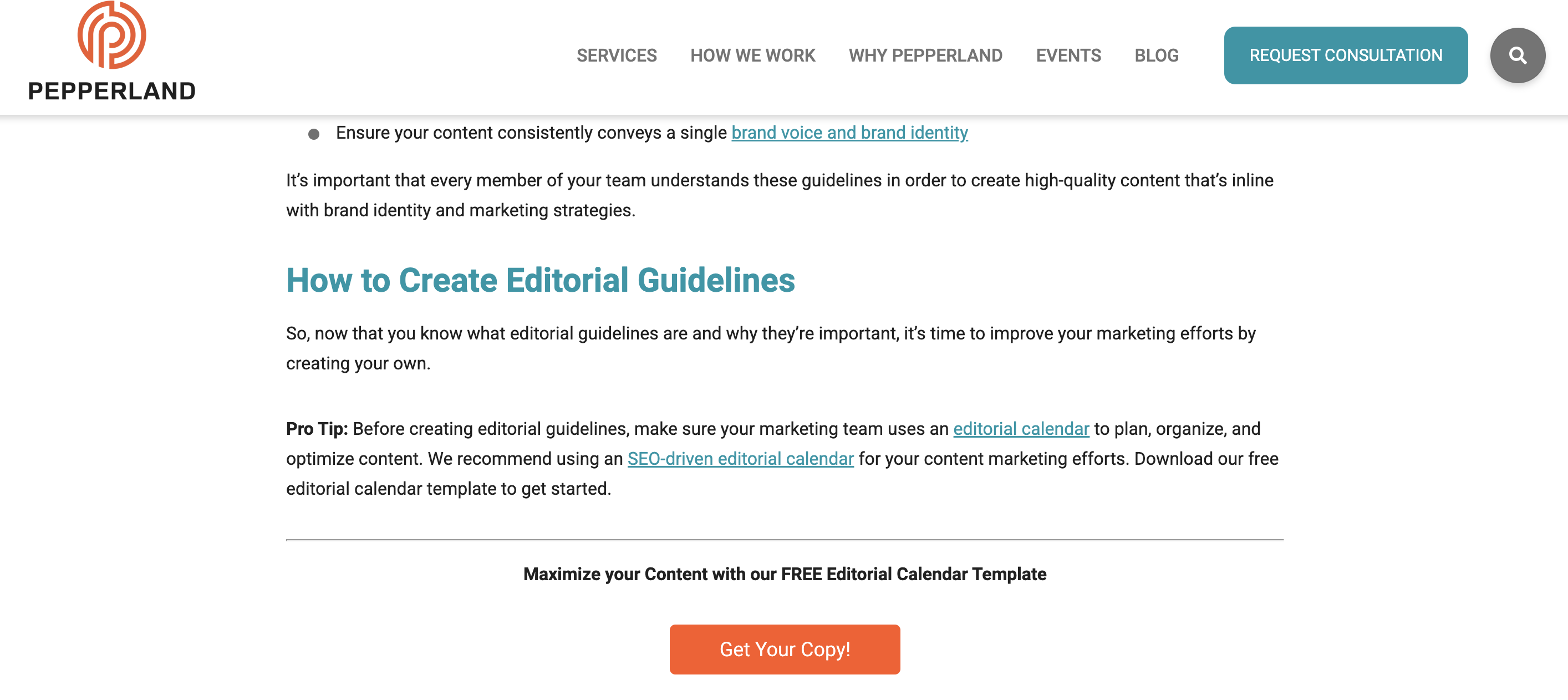
After taking a more big picture view I recognized needed more focused guidance on the step by step of creating editorial guidelines.
I really liked the content the good folks at Pepperland Marketing have created, including a free template – thanks guys! – and in part what inspired me to create our own free template as a way of sharing learnings and helping others quickstart the process of creating their own guidelines.
3. Writing guidelines for the role of AI in your newsroom?… Nieman Lab

As well as provide guidance on content quality and the content creation process, I wanted to tackle the thorny topic of AI in our editorial guidelines. Specifically, to give content creators a steer on ‘fair’ use of AI when creating content, to ensure creators get to benefit from the amazing power of these tools, but also that content is not created 100% by AI and help them understand why we feel that contravenes our core content principles of content quality.
So, to learn more I devoured this fascinating article, sourcing guidance from major media outlets around the world. I know things change very quickly when it comes to AI, but I highly encourage reading this and taking inspiration from how these media outlets are tackling this topic.
Learn more: The Marketer’s Guide to AI-generated content
Why did we decide to create editorial guidelines?
1. Aligning content creators to a clear vision and process
Optimizely as a business has undergone a huge transformation over the last 3 years, going through rapid acquisition and all the joys and frustrations that can bring. As a content team, we quickly recognized the need to create a set of clear and engaging guidelines that helps content creators understand how and where they can contribute, and gave a clear process to follow when submitting a content idea for consideration.
2. Reinvigorated approach to brand and content
As a brand Optimizely is also going through a brand evolution – moving from a more formal, considered tone of voice to one that’s much more approachable, down to earth and not afraid to use humor, different in content and execution.
See, our latest CMS campaign creative:
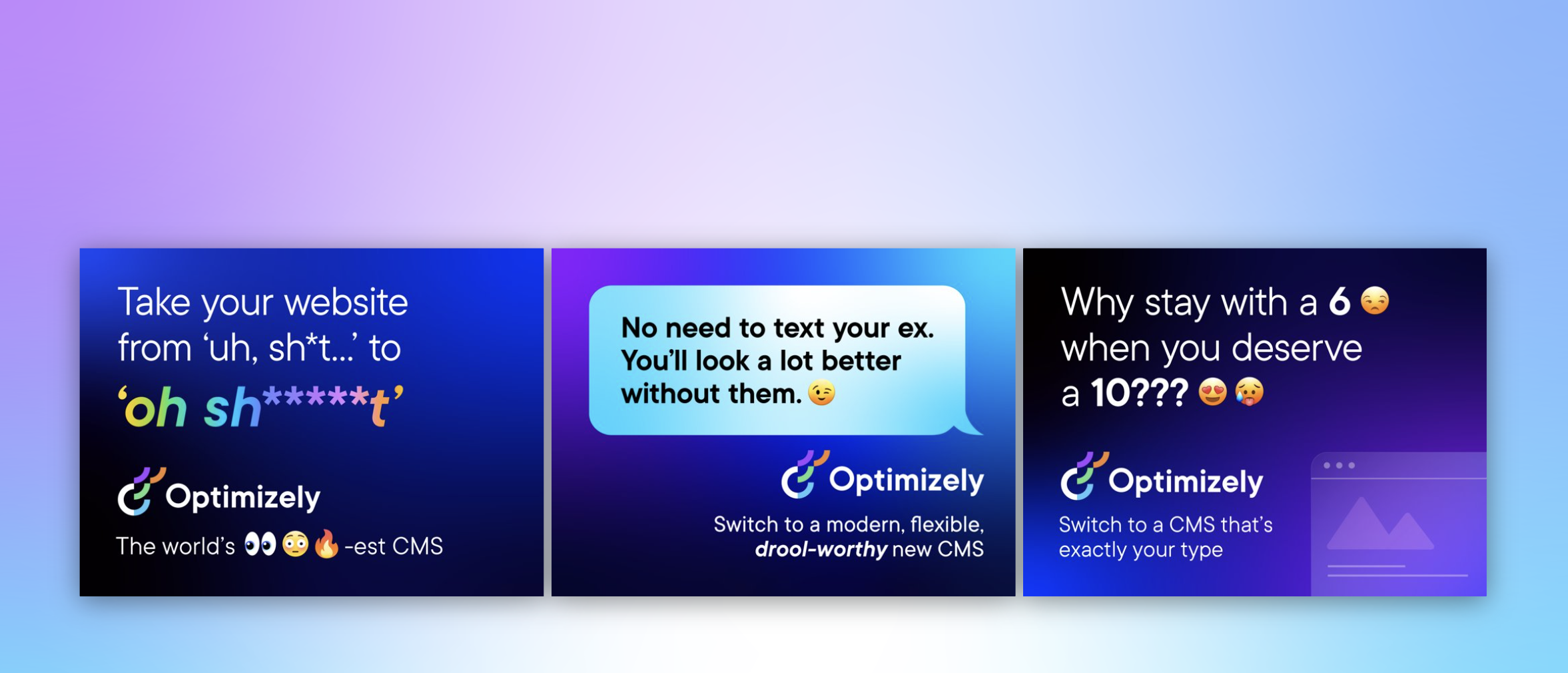
It’s pretty out there in terms of creative and messaging. It’s an ad campaign that’s designed to capture attention yes, but also – to demonstrate our abilities as a marketing team to create this type of campaign that is normally reserved for other more quote unquote creative industries.
We wanted to give guidance to fellow content creators outside the team on how they can also create content that embraces this evolved tone of voice, while at the same time ensuring content adheres to our brand guidelines.
3. Streamline content creation process
Like many global enterprises we have many different content creators, working across different time zones and locations. Documenting a set of guidelines and making them easily available helps content creators quickly understand our content goals, the types of content we want to create and why. It would free up content team time spent with individual contributors reviewing and editing submissions, and would ensure creation and optimization aligns to broader content & business goals.
It was also clear that we needed to document a process for submitting content ideas, so we made sure to include this in the guidelines themselves to make it easy and accessible for all contributors.
4. 2023 retrospective priority
As a content team we regularly review our content strategy and processes to ensure we’re operating as efficiently as possible.
In our last retrospective. I asked my team ‘what was the one thing I could do as a manager to help them be more impactful in their role?’
Editorial guidelines was the number 1 item on their list.
So off we went…
What we did
- Defined a discrete scope of work for the first version of the editorial guidelines, focusing on the Blog and Resources section of the website. This is where the content team spends most of its time and so has most involvement in the content creation process. Also where the most challenging bottlenecks have been in the past
- Research. Reviewed what was out there, got my hands on a few free templates and assembled a framework to create a first version for inputs and feedback
- Asked content community – I put a few questions out to my network on LinkedIn on the topic of content guidelines and content strategy, seeking to get input and guidance from smart marketers.
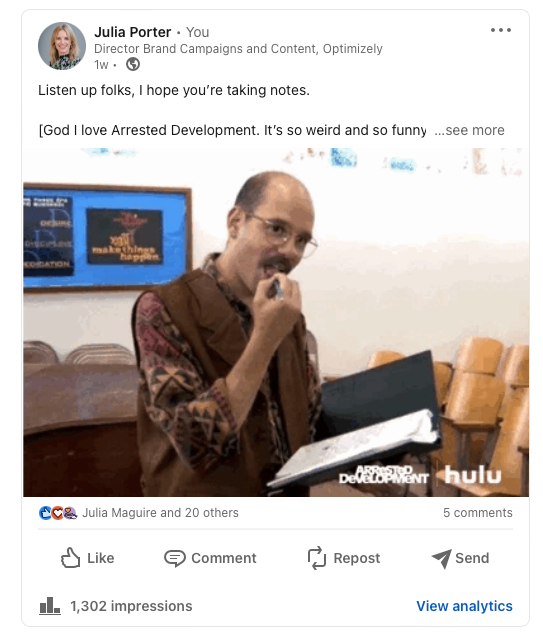
- Invited feedback: Over the course of a few weekswe invited collaborators to comment in a shared doc as a way of taking iterative feedback, getting ideas for the next scope of work, and also – bringing people on the journey of creating the guidelines. Look at all those reviewers! Doing this within our Content Marketing Platform (CMP) ensured that all that feedback was captured in one place, and that we could manage the process clearly, step by step:
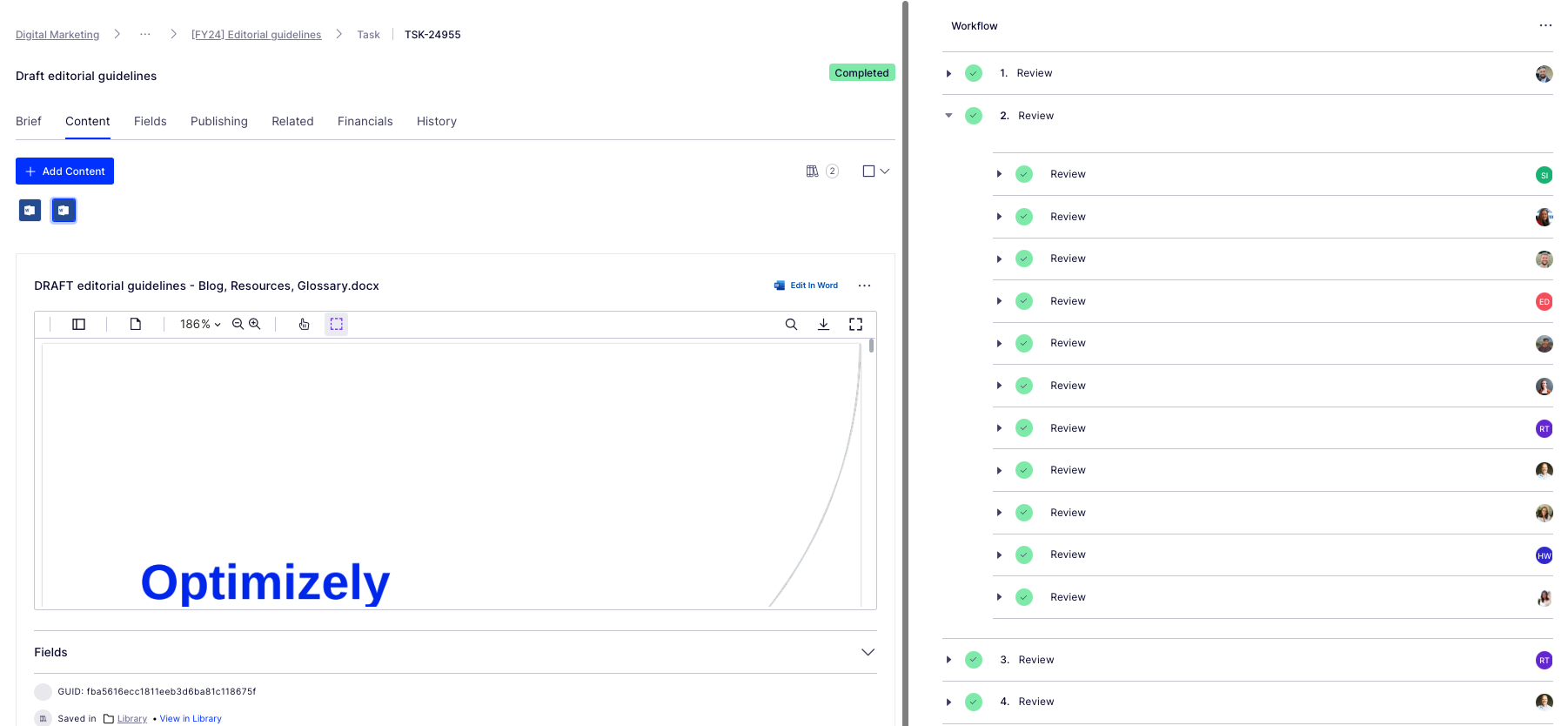
Look at all those collaborators! Thanks guys! And all of those beautiful ticks, so satisfying. So glad I could crop out the total outstanding tasks for this screen grab too (Source – Optimizely CMP)
- Updated content workflow: Now we have clear, documented guidance in place, we’ve included this as a step – the first step – in the workflow used for blog post creation:
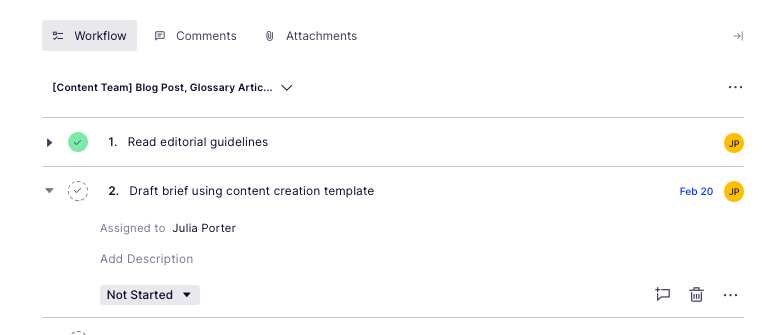
Source: Optimizely CMP
Results
It’s early days but we’re already seeing more engagement with the content creation process, especially amongst the teams involved in building the guidelines (which was part of the rationale in the first place :))

Source: My Teams chat
It’s inspired teams to think differently about the types of content we want to produce going forwards – for the blog and beyond.
I’d also say it’s boosted team morale and collaboration, helping different teams work together on shared goals to produce better quality work.
What’s next?
We’re busy planning wider communication of the editorial guidelines beyond marketing. We’ve kept the original draft and regularly share this with existing and potential collaborators for ongoing commentary, ideas and feedback.
Creating guidelines has also sparked discussion about the types of briefs and templates we want and need to create in CMP to support creating different assets. Finding the right balance between creative approach and using templates to scale content production is key.
We’ll review these guidelines on a quarterly basis and evolve as needed, adding new formats and channels as we go.
Key takeaways
- Editorial guidelines are a useful way to guide content creators as part of your overall content strategy
- Taking the time to do research upfront can help accelerate seemingly complex projects. Don’t be afraid to ask your community for inputs and advice as you create
- Keep the scope small at first rather than trying to align everything all at once. Test and learn as you go
- Work with stakeholders to build guidelines from the ground up to ensure you create a framework that is useful, relevant and used
And lastly, here’s that free template we created to help you build or evolve your own editorial guidelines!
MARKETING
Effective Communication in Business as a Crisis Management Strategy

Everyday business life is full of challenges. These include data breaches, product recalls, market downturns and public relations conflicts that can erupt at any moment. Such situations pose a significant threat to a company’s financial health, brand image, or even its further existence. However, only 49% of businesses in the US have a crisis communications plan. It is a big mistake, as such a strategy can build trust, minimize damage, and even strengthen the company after it survives the crisis. Let’s discover how communication can transform your crisis and weather the chaos.
The ruining impact of the crisis on business
A crisis can ruin a company. Naturally, it brings losses. But the actual consequences are far worse than lost profits. It is about people behind the business – they feel the weight of uncertainty and fear. Employees start worrying about their jobs, customers might lose faith in the brand they once trusted, and investors could start looking elsewhere. It can affect the brand image and everything you build from the branding, business logo, social media can be ruined. Even after the crisis recovery, the company’s reputation can suffer, and costly efforts might be needed to rebuild trust and regain momentum. So, any sign of a coming crisis should be immediately addressed. Communication is one of the crisis management strategies that can exacerbate the situation.
The power of effective communication
Even a short-term crisis may have irreversible consequences – a damaged reputation, high employee turnover, and loss of investors. Communication becomes a tool that can efficiently navigate many crisis-caused challenges:
- Improved trust. Crisis is a synonym for uncertainty. Leaders may communicate trust within the company when the situation gets out of control. Employees feel valued when they get clear responses. The same applies to the customers – they also appreciate transparency and are more likely to continue cooperation when they understand what’s happening. In these times, documenting these moments through event photographers can visually reinforce the company’s messages and enhance trust by showing real, transparent actions.
- Reputation protection. Crises immediately spiral into gossip and PR nightmares. However, effective communication allows you to proactively address concerns and disseminate true information through the right channels. It minimizes speculation and negative media coverage.
- Saved business relationships. A crisis can cause unbelievable damage to relationships with employees, customers, and investors. Transparent communication shows the company’s efforts to find solutions and keeps stakeholders informed and engaged, preventing misunderstandings and painful outcomes.
- Faster recovery. With the help of communication, the company is more likely to receive support and cooperation. This collaborative approach allows you to focus on solutions and resume normal operations as quickly as possible.
It is impossible to predict when a crisis will come. So, a crisis management strategy mitigates potential problems long before they arise.
Tips on crafting an effective crisis communication plan.
To effectively deal with unforeseen critical situations in business, you must have a clear-cut communication action plan. This involves things like messages, FAQs, media posts, and awareness of everyone in the company. This approach saves precious time when the crisis actually hits. It allows you to focus on solving the problem instead of intensifying uncertainty and panic. Here is a step-by-step guide.
Identify your crisis scenarios.
Being caught off guard is the worst thing. So, do not let it happen. Conduct a risk assessment to pinpoint potential crises specific to your business niche. Consider both internal and external factors that could disrupt normal operations or damage the online reputation of your company. Study industry-specific issues, past incidents, and current trends. How will you communicate in each situation? Knowing your risks helps you prepare targeted communication strategies in advance. Of course, it is impossible to create a perfectly polished strategy, but at least you will build a strong foundation for it.
Form a crisis response team.
The next step is assembling a core team. It will manage communication during a crisis and should include top executives like the CEO, CFO, and CMO, and representatives from key departments like public relations and marketing. Select a confident spokesperson who will be the face of your company during the crisis. Define roles and responsibilities for each team member and establish communication channels they will work with, such as email, telephone, and live chat. Remember, everyone in your crisis response team must be media-savvy and know how to deliver difficult messages to the stakeholders.
Prepare communication templates.
When a crisis hits, things happen fast. That means communication needs to be quick, too. That’s why it is wise to have ready-to-go messages prepared for different types of crises your company may face. These messages can be adjusted to a particular situation when needed and shared on the company’s social media, website, and other platforms right away. These templates should include frequently asked questions and outline the company’s general responses. Make sure to approve these messages with your legal team for accuracy and compliance.
Establish communication protocols.
A crisis is always chaotic, so clear communication protocols are a must-have. Define trigger points – specific events that would launch the crisis communication plan. Establish a clear hierarchy for messages to avoid conflicting information. Determine the most suitable forms and channels, like press releases or social media, to reach different audiences. Here is an example of how you can structure a communication protocol:
- Immediate alert. A company crisis response team is notified about a problem.
- Internal briefing. The crisis team discusses the situation and decides on the next steps.
- External communication. A spokesperson reaches the media, customers, and suppliers.
- Social media updates. A trained social media team outlines the situation to the company audience and monitors these channels for misinformation or negative comments.
- Stakeholder notification. The crisis team reaches out to customers and partners to inform them of the incident and its risks. They also provide details on the company’s response efforts and measures.
- Ongoing updates. Regular updates guarantee transparency and trust and let stakeholders see the crisis development and its recovery.
Practice and improve.
Do not wait for the real crisis to test your plan. Conduct regular crisis communication drills to allow your team to use theoretical protocols in practice. Simulate different crisis scenarios and see how your people respond to these. It will immediately demonstrate the strong and weak points of your strategy. Remember, your crisis communication plan is not a static document. New technologies and evolving media platforms necessitate regular adjustments. So, you must continuously review and update it to reflect changes in your business and industry.
Wrapping up
The ability to handle communication well during tough times gives companies a chance to really connect with the people who matter most—stakeholders. And that connection is a foundation for long-term success. Trust is key, and it grows when companies speak honestly, openly, and clearly. When customers and investors trust the company, they are more likely to stay with it and even support it. So, when a crisis hits, smart communication not only helps overcome it but also allows you to do it with minimal losses to your reputation and profits.
-
SEARCHENGINES7 days ago
Daily Search Forum Recap: April 19, 2024
-

 WORDPRESS6 days ago
WORDPRESS6 days ago13 Best HubSpot Alternatives for 2024 (Free + Paid)
-

 WORDPRESS7 days ago
WORDPRESS7 days ago7 Best WooCommerce Points and Rewards Plugins (Free & Paid)
-

 MARKETING6 days ago
MARKETING6 days agoBattling for Attention in the 2024 Election Year Media Frenzy
-

 MARKETING6 days ago
MARKETING6 days agoAdvertising in local markets: A playbook for success
-

 SEO7 days ago
SEO7 days agoGoogle Answers Whether Having Two Sites Affects Rankings
-

 SEARCHENGINES6 days ago
SEARCHENGINES6 days agoGoogle Core Update Flux, AdSense Ad Intent, California Link Tax & More
-

 AFFILIATE MARKETING6 days ago
AFFILIATE MARKETING6 days agoGrab Microsoft Project Professional 2021 for $20 During This Flash Sale






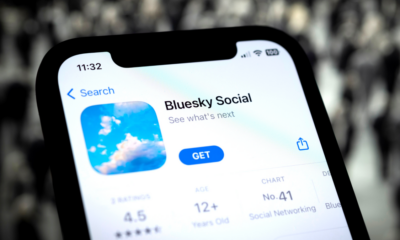



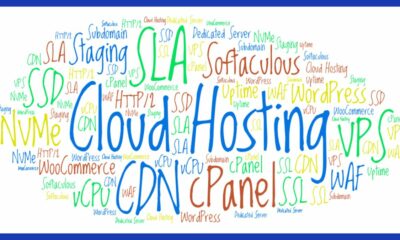




You must be logged in to post a comment Login